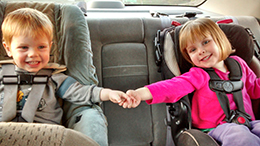
When buying car seats for your kids, make sure to account for their age, weight and height. Photo: American Ratings Corporation (2015)
The other day, I was about to hop in the back seat of my friend’s SUV, but I quickly changed my mind. The child safety seats—one for an infant and one for a preschooler—had been carefully installed and appeared to be permanently locked down.
Car seats have improved dramatically in both safety and design since they gained more widespread use in the ’70s. Today, most people know that young children should sit in the back of a car and use some kind of safety seat until they’re about 12 years old, depending on their weight. You’ll probably have to invest in three different types of seats (which I’ll describe below) before your children are old enough to use regular seatbelts.
Infant seats have detachable carriers and are used facing backward. Most will accommodate kids up to 40 pounds.
Convertible seats can be used facing forward or backward and are designed for children up to 70 pounds. A convertible seat should be rear-facing until your child reaches the height or weight limit of the seat, at which point it can be turned around in the back seat.
Booster seats are used once your child gets too big for a convertible seat. The booster allows children to be high enough for the seat belt to fit them correctly. Safety experts prefer boosters with high backs for better positioning of the shoulder belts. Kids outgrow booster seats when they’re 8 to 12 years old and about 57 inches tall.
Buying your first safety seat can be overwhelming—besides fitting your child, it’s important to make sure the seat will work in your particular car. Fortunately, Consumer Reports magazine just rated different safety seats using a new and improved crash test protocol that’s designed to help you choose wisely (September 2015 issue). Safety experts also suggest having your seat installation checked. The Bay Area has many inspection stations, which you can find by entering your zip code at www.seatcheck.org.
A couple of final points: A seat can be reused, but be sure to look for its expiration date (seats expire because they’re made of plastic and weaken over time). And once a car seat has been damaged in a crash, it should be discarded.
Extra: History of the car seat slideshow
